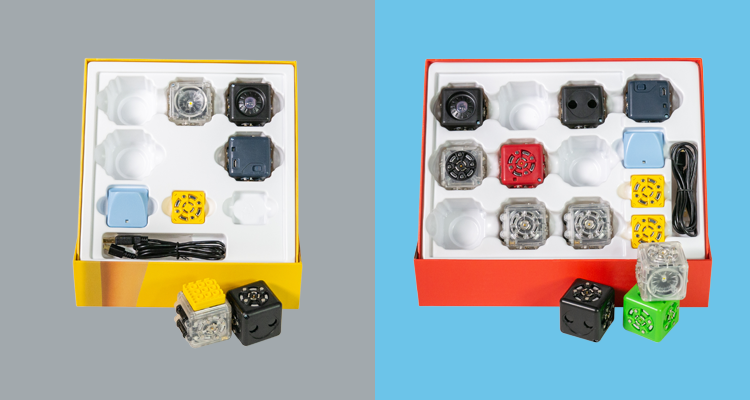While having Cubelets for a whole class is the dream, a single group of Cubelets can be just as effective of a teaching tool. Because the Curiosity Set and Discovery Set are small, they are sometimes overlooked when teachers plan for their classrooms. But the size of the Curiosity and Discovery Sets can actually be an asset. Not only do they give more flexibility to smaller budgets (you can get five Curiosity Sets or nine Discovery Sets for less than one Mini Makers Pack), their sleek design and creative internal packaging are actually extremely helpful in keeping track of these valuable computer science tools. So how do the Curiosity and Discovery Sets serve you in the classroom?
On Their Own
The Curiosity Set and Discovery Set were both designed to support one robot group. This makes them perfect investments for classrooms who plan to use Cubelets as a single station within a workshop-model classroom or a smaller resource within a robust Makerspace. Many schools like to tiptoe into computer science by trying it out with lunch clubs or makerspaces that incorporate a smorgasbord of potential resources. It is common for a school to purchase a few Curiosity Sets or Discovery Sets for their first foray into Cubelets. That’s enough Cubelets for a couple groups to build robots simultaneously.
The great thing about both sets is they are packaged to enable easy accountability and management.
First, each group has their own box. All you need to do is label each box to keep track of which group is responsible for which kit!
Then look inside at the careful layout. Each Cubelet has its own designated spot within the box! All you’ll need to do is write the name of each Cubelet in its cubby. You could also print out this Cubelets Catalogue and paste the corresponding images in the proper places.

Now you can quickly scan each box to make sure all Cubelets are accounted for and you’ll know which group to follow-up with as needed.
The Curiosity Set v. the Discovery Set
What are your goals for your students? The Discovery and Curiosity Sets each have a niche that they best fit.
The Discovery Set requires students to flex their coding skills early using the Cubelets App and Cubelets Blockly, but won’t support all of the lesson plans and Activity Cards. Instead, students will need a bluetooth-enabled device and access to our Create with Cubelets video series to get them up and running.
The Curiosity Set, on the other hand, encourages students to develop their understanding of computer science using Tactile Coding. The Curiosity Set also enables students to participate in almost every lesson plan and Activity Card as well as code with the Cubelets App and Cubelets Blockly. In addition, students will be able to create more traditional steering robots like the maze-solver we referenced in a recent blog post.
Expansions
You may already have some Cubelets and it might be time to expand your robot building options. The Curiosity Set and Discovery Set make great expansions to Cubelets collections. It’s easy to add one or two student groups if your class size explodes. (When I was teaching, I had 25 students one year, and then 33 the next! We needed at least 2 extra student groups for every single resource all year long, and when class sizes decreased, the school had an ample collection of replacement parts and extra consumables to last several more years.)
Having the flexibility to buy Cubelets one student group at a time can be a huge asset for schools, camps, and museums. Still have questions about the Curiosity or Discovery Sets? Let us know or sign up for our free Review Kit program and try the Curiosity out yourself!
Enjoyed this blog post? Sign up for the #CubeletsChat newsletter to receive the next blog post straight to your inbox. Plus join the discussion on twitter using the #CubeletsChat hashtag!


